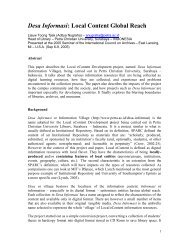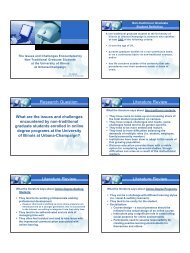The Biological Information Browsing Environment (BIBE)
The Biological Information Browsing Environment (BIBE)
The Biological Information Browsing Environment (BIBE)
Create successful ePaper yourself
Turn your PDF publications into a flip-book with our unique Google optimized e-Paper software.
<strong>Biological</strong> <strong>Information</strong><strong>Browsing</strong> <strong>Environment</strong>http://www.biobrowser.orgWhat Is That Butterfly?Joan is working as a volunteer,helping to identify and countbutterflies for an environmentalevaluation group. When she seesher first butterfly, she consults<strong>BIBE</strong> to help identify it.
<strong>The</strong> <strong>Biological</strong> <strong>Information</strong> <strong>Browsing</strong> <strong>Environment</strong> (<strong>BIBE</strong>) is a facility to help novices and expertsfind information about plants and animals in digital collections. <strong>The</strong> Project is funded by the National ScienceFoundation <strong>Biological</strong> Databases and Informatics Program and is a collaboration between the GraduateSchool of Library and <strong>Information</strong> Science at the University of Illinois, Illinois Natural History Survey,Missouri Botanical Garden, Flora of North America Project at the Harvard Herbarium, and Illinois Departmentof Natural Resources.<strong>The</strong> objectives of the Project are to facilitate access to online flora and fauna by both novices and expertsthrough enhanced indexing, searching, and visualization techniques. Specific search facility and content willbe added to help users with different levels of domain knowledge identify species based on the augmentationof professionally developed taxonomic treatments or species descriptions. This is a novel use of taxonomicdescriptions. In the course of development the system will undergo a series of qualitative and quantitativeevaluations and re-designs by several communities of users, including professional entomologists and botanistsas well as citizen scientists performing biodiversity surveys.For more details, see an article by P. Bryan Heidorn, PI on the project, entitled “A Tool for MultipurposeUse of Online Flora and Fauna: <strong>The</strong> <strong>Biological</strong> <strong>Information</strong> <strong>Browsing</strong> <strong>Environment</strong> (<strong>BIBE</strong>)” in the FirstMonday (Volume 6, Number 2 - February 5th 2001), a peer-reviewed journal on the Internet.Related projects:<strong>The</strong> BioDiversity Collaboration <strong>Environment</strong>Much field data for ecology and biodiversity studies uses data collected from hundreds of mostly novice collaborators.<strong>The</strong> BioDiversity Collaboration <strong>Environment</strong> (BDCE) will facilitate the collection and use of this data. BDCEwill address the issues of distributed intelligence, field support, mobile computing, remote training, data qualityand coordination of information across time and space, with real-time expert feedback.<strong>Information</strong> technology could fundamentally change the way we understand the world and the way science indone. Substantial improvements in science can be made if the information technology is carefully developed andintegrated. <strong>The</strong> system will integrate collaboration, collection development, information retrieval, and informationcreation and management. A key component of the technology is the development of software agents that willanalyze the needs of survey members, prior surveys of the same site, museum record and other resources to createa customized collection of digital support material that can be put on disk and taken to the field, thereby overcomingbandwidth problems.Illinois - North Carolina Collaborative <strong>Environment</strong> for Botanical Resources<strong>The</strong> Illinois - North Carolina Collaborative <strong>Environment</strong> for Botanical Resources seeks to revolutionize accessto botanical resources by incorporating the methods botanists use to identify plant species and by simplifying andvisualizing the process of identification. This project is supported by a partnership between the University ofIllinois at Urbana Champaign (UIUC) and the University of North Carolina at Chapel Hill (UNC-CH), two leadinginformation science institutions. <strong>The</strong> project's major goals include creating four distributed polyclave keys thatwill visually capture the way botanical experts identify species; teaching and observing nonprofessionals in usingand testing these keys for species identification; enlisting community citizens in documenting selected planthabitats in four important environmental monitoring projects (PrairieWatch and ForestWatch in Illinois andWildflower and TreeWatch in North Carolina); creating a use-based collection of botanical resources to supportbiodiversity surveys; providing citizen and experts with access to a larger array of botanical resources through aUIUC and UNC-CH collaborative collection development and digitization plan; and producing an informationstore of high-quality botanical images that support species identification. <strong>The</strong> design of the project provides aframework that will foster scientific learning by citizen scientists who want to assist in documenting plant habitsnecessary for monitoring changes in the environment. <strong>The</strong> polyclave keys with data gathered by citizen scientistswill be made available to other libraries and museums throughout the World Wide Web after development andtesting. We will actively promote the use of the polyclave keys, enhance the flow of scientific information, andshare expert investigative processes with other botanists and nonprofessionals who want to expand their knowledgeof the natural world and contribute to the documentation of plant habits.















